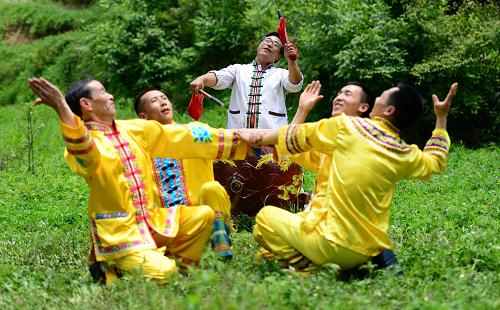


“Saye’erhe”dance (Photo/Xinhua)
Technologies have provided solutions to protect and inherit China’s intangible cultural heritage items. With motion capture, virtual reality, and panoramic display, various forms of Chinese folk culture have been brought back to life once again.
State of the art technologies make folk culture inheritance much easier
“Saye’erhe” is a kind of folk song and dance of the Tujia ethnic group in central China’s Hubei province. The folk culture was put on the national list of intangible cultural heritage of China in 2006.
But nowadays, instead of learning the folk songs and dances, more people have left their hometown in the countryside to work in cities.
In 2015, Zhang Yinghui, director of the Changyang intangible cultural heritage protection center, a local organization in Hubei, and Sun Chuanming, an associate professor of culture industry research at Central China Normal University (CCNU) proposed to use three-dimensional motion capture to digitalize the folk culture.
Three performers were chosen to perform “Saye’erhe” at a lab of CCNU. The performance was first recorded and animated, and then the movements of the dancers were edited on the computer to make sure they were standard.
In fact at present, more people are learning “Saye’erhe” from these animated videos. They can even watch the movements from different angles and play as a certain character seen within the performance.
High technologies revitalize intangible cultural heritage items
What will come out if VR if used to visualize dances? It’s fun. An exhibition center in north China’s Inner Mongolia Autonomous Region has rolled out a hologram theater, which allows spectators the opportunity to dance with virtual dancers.
Through the program, a lot of tourists have fallen in love with the traditional dances of the Mongolian ethnic group, such as the chopsticks dance and the bowl dance. In addition to the activities mentioned above, they can also experience local wedding ceremonies, sports and religious rituals.
Zhao Zhiming, general manager of a local culture and media company, said digitalization has revitalized intangible cultural items, adding that his company will strengthen cooperation with culture inheritors, and boost culture protection by means of big data utilization.
The animated intangible cultural items are popular among children, laying a more solid foundation for cultural inheritance, said Zhang.
 Fire brigade in Shanghai holds group wedding
Fire brigade in Shanghai holds group wedding Tourists enjoy ice sculptures in Datan Town, north China
Tourists enjoy ice sculptures in Datan Town, north China Sunset scenery of Dayan Pagoda in Xi'an
Sunset scenery of Dayan Pagoda in Xi'an Tourists have fun at scenic spot in Nanlong Town, NW China
Tourists have fun at scenic spot in Nanlong Town, NW China Harbin attracts tourists by making best use of ice in winter
Harbin attracts tourists by making best use of ice in winter In pics: FIS Alpine Ski Women's World Cup Slalom
In pics: FIS Alpine Ski Women's World Cup Slalom Black-necked cranes rest at reservoir in Lhunzhub County, Lhasa
Black-necked cranes rest at reservoir in Lhunzhub County, Lhasa China's FAST telescope will be available to foreign scientists in April
China's FAST telescope will be available to foreign scientists in April "She power" plays indispensable role in poverty alleviation
"She power" plays indispensable role in poverty alleviation Top 10 world news events of People's Daily in 2020
Top 10 world news events of People's Daily in 2020 Top 10 China news events of People's Daily in 2020
Top 10 China news events of People's Daily in 2020 Top 10 media buzzwords of 2020
Top 10 media buzzwords of 2020 Year-ender:10 major tourism stories of 2020
Year-ender:10 major tourism stories of 2020 No interference in Venezuelan issues
No interference in Venezuelan issues
 Biz prepares for trade spat
Biz prepares for trade spat
 Broadcasting Continent
Broadcasting Continent Australia wins Chinese CEOs as US loses
Australia wins Chinese CEOs as US loses